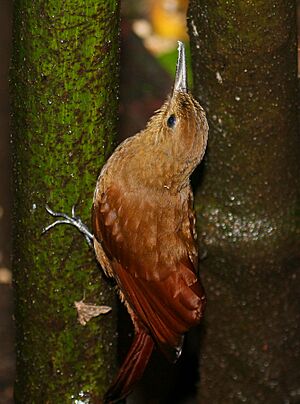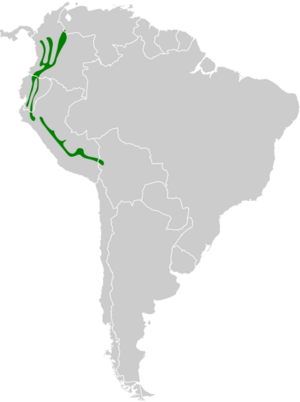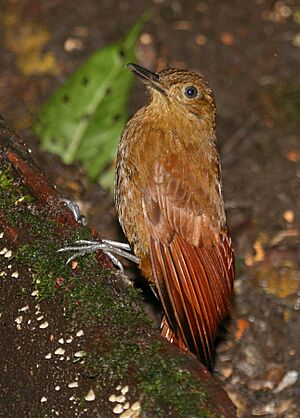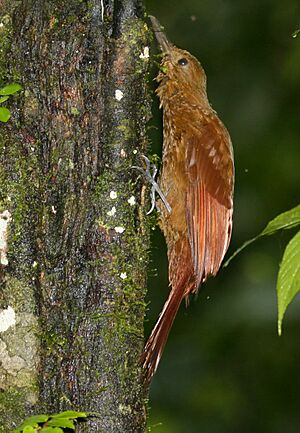Tyrannine woodcreeper facts for kids
Quick facts for kids Tyrannine woodcreeper |
|
|---|---|
 |
|
| Tandayapa Valley, NW Ecuador | |
| Conservation status | |
| Scientific classification | |
| Genus: |
Dendrocincla
|
| Species: |
tyrannina
|
 |
|
The tyrannine woodcreeper (scientific name: Dendrocincla tyrannina) is a type of bird. It belongs to the ovenbird family, called Furnariidae. You can find this bird in countries like Bolivia, Colombia, Ecuador, Peru, and Venezuela.
Contents
About This Bird's Family
Birds, like all living things, are grouped by scientists. The tyrannine woodcreeper has two main types, called subspecies. These are D. t. tyrannina, first described by Lafresnaye in 1851, and D. t. hellmayri, described by Cory in 1913.
What the Tyrannine Woodcreeper Looks Like
The tyrannine woodcreeper is bigger and heavier than many other birds in its group. It is about 23 to 26.5 centimeters (9 to 10.4 inches) long. It weighs between 40 and 64 grams (1.4 to 2.3 ounces). Male and female birds look similar, but males are usually a bit heavier.
The most common type, D. t. tyrannina, is mostly warm brown. It has a lighter throat and faint light streaks on its head. Its wings and tail have a reddish-brown color, which is called rufescent.
The other type, D. t. hellmayri, is more olive-brown. Its wings and tail are less reddish-brown. Both types have eyes that are brown to bluish-gray. Their legs and feet are gray to blackish. Their large beak has a brownish-gray to black upper part (maxilla) and a brownish to bluish-gray lower part (mandible).
Where the Tyrannine Woodcreeper Lives
The D. t. tyrannina subspecies lives in the Andes mountains of Colombia. It also lives south through Ecuador and Peru, reaching a bit into Bolivia. The D. t. hellmayri subspecies is found on the eastern side of Colombia's Eastern Andes and in nearby western Venezuela.
These birds like to live in humid, cool mountain forests. They prefer the inside of old, untouched forests. However, they can also be found at the edges of these forests or in older forests that have grown back. They rarely go into open areas.
They live at different heights depending on the country. In Venezuela, they are found between 1,800 and 2,300 meters (5,900 and 7,500 feet) high. In Colombia, they mostly live between 1,500 and 3,000 meters (4,900 and 9,800 feet). In Ecuador, they are found between 1,400 and 3,100 meters (4,600 and 10,200 feet).
How the Tyrannine Woodcreeper Behaves
Movement
The tyrannine woodcreeper stays in the same area all year round. It does not migrate.
Feeding Habits
Scientists do not know all the details about what the tyrannine woodcreeper eats. But they believe it mainly eats insects. This bird usually looks for food alone. Sometimes, it joins groups of different bird species that are feeding together.
It climbs up tree trunks and along branches. From there, it makes quick flights to catch insects in the air. It rarely picks up prey directly from the tree surface. This bird also does not often follow swarms of army ants, which many other birds do. It typically feeds fairly low in the forest, usually between 2 and 15 meters (7 and 49 feet) above the ground.
Life Cycle and Reproduction
Not much is known about how the tyrannine woodcreeper reproduces. Because it tends to be a solitary bird, it might not form long-term pairs. It builds its nest inside a tree cavity. It lines the bottom of the cavity with soft materials. One nest found in Ecuador had a single egg. Young birds leave the nest at least 29 days after hatching. The time it takes for the egg to hatch and how the parents care for their young are still unknown.
Vocalizations
The tyrannine woodcreeper often sings from the top branches of a tree on a ridge. Its song is a long, rattling sound that slowly gets higher in pitch and louder. Then it fades away and slows down towards the end. Its call is a fast series of 3 to 6 short, sharp notes, like "di-di-di-di-dik!" It also makes a hollow, whistling sound, like "que-up."
Conservation Status
The International Union for Conservation of Nature (IUCN) has listed the tyrannine woodcreeper as a species of "Least Concern." This means it is not currently in danger of disappearing. It lives across a large area, but its total population size is unknown. Scientists believe its numbers are decreasing.
No immediate big threats have been found for this bird. It is rare or uncommon in most places it lives. It is only found in a narrow band of elevation in the mountains. It does live in a few protected areas. However, it seems to be very sensitive to human activities in areas where forests are being cut down. Because of this, its conservation status might need to be looked at again in the future.




